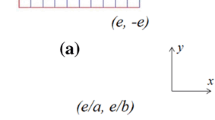Abstract
Superscatterer is typically made of complementary media for expanding the scope of scattering. The fact that superscatterer can make object appear bigger than its geometric size provides the possibility of equivalently enlarging and moving coils in inductive coupling system. In this paper, we demonstrate that the superscatterer without perfect electrical conductor can also expand the distribution of magnetic field with a source inside. Based on transformation optics, a spherical superscatterer is designed and simulated especially in near field. A model of two-coil inductive coupling system is numerically analyzed to prove the enhancement on mutual coupling by superscatterer. Finally, we also discuss the simplification of such superscatterer for fabrication concerns.








Similar content being viewed by others
References
J.B. Pendry, D. Schurig, D.R. Smith, Controlling electromagnetic fields. Science 312(5781), 1780–1782 (2006)
D. Schurig, J.B. Pendry, D.R. Smith, Calculation of material properties and ray tracing in transformation media. Opt. Express 14(21), 9794–9804 (2006)
S.A. Cummer, R. Liu, T.J. Cui, A rigorous and nonsingular two dimensional cloaking coordinate transformation. J. Appl. Phys. 105(5) (2009)
H.Y. Chen, C.T. Chan, Transformation media that rotate electromagnetic fields. Appl. Phys. Lett. 90(24) (2007)
F.M. Kong, et al., Planar focusing antenna design by using coordinate transformation technology. Appl. Phys. Lett. 91(25) (2007)
D. Schurig et al., Metamaterial electromagnetic cloak at microwave frequencies. Science 314(5801), 977–980 (2006)
G.W. Milton et al., A proof of superlensing in the quasistatic regime, and limitations of superlenses in this regime due to anomalous localized resonance. Proc. R. Soc. Lond. Ser. 461(2064), 3999–4034 (2005)
X.D Luo et al., Conceal an entrance by means of superscatterer. Appl. Phys. Lett. 94(22) (2009)
W.H. Wee, J.B. Pendry, Shrinking optical devices. New J. Phys. 11 (2009)
T. Yang et al., Superscatterer: enhancement of scattering with complementary media. Opt. Express 16(22), 18545–18550 (2008)
D.R. Smith et al., Composite medium with simultaneously negative permeability and permittivity. Phys. Rev. Lett. 84(18), 4184–4187 (2000)
A. Rajagopalan et al., Improving power transfer efficiency of a short-range telemetry system using compact metamaterials. IEEE Trans. Microw. Theory Tech 62(4), 947–955 (2014)
O.M. Ramahi, et al., Metamaterial particles for electromagnetic energy harvesting. Appl. Phys. Lett. 101(17) (2012)
B.N. Wang, et al., Experiments on wireless power transfer with metamaterials. Appl. Phys. Lett. 98(25) (2011)
J.B. Pendry, Negative refraction makes a perfect lens. Phys. Rev. Lett. 85(18), 3966–3969 (2000)
D. Huang, et al., Magnetic superlens-enhanced inductive coupling for wireless power transfer. J. Appl. Phys. 111(6) (2012)
J.B. Pendry, S.A. Ramakrishna, Focusing light using negative refraction. J. Phys. Condens. Matter 15(37), 6345–6364 (2003)
X.H. Zhang et al., Transformation media that turn a narrow slit into a large window. Opt. Express 16(16), 11764–11768 (2008)
M. Rahm et al., Design of electromagnetic cloaks and concentrators using form-invariant coordinate transformations of Maxwell’s equations. Photo. Nano. Fund. Appl. 6(1), 87–95 (2008)
H.Y. Chen, Transformation optics in orthogonal coordinates. J. Opt. A Pure Appl. Opt. 11(7) (2009)
G.W. Milton, et al., Solutions in folded geometries, and associated cloaking due to anomalous resonance. New J. Phys. 10 (2008)
H.X. Xu et al., Superscatterer illusions without using complementary media. Adv. Opt. Mater. 2(6), 572–580 (2014)
Y. Huang, Y. Feng, T. Jiang, Electromagnetic cloaking by layered structure of homogeneous isotropic materials. Opt. Express 15(18), 11133–11141 (2007)
C.W. Qiu, et al., Spherical cloaking with homogeneous isotropic multilayered structures. Phys. Rev. E. 79(4) (2009)
Z.Z. Yu, et al., Optimized cylindrical invisibility cloak with minimum layers of non-magnetic isotropic materials. J. Phys. D Appl. Phys. 44(18) (2011)
D.R. Smith, et al., Determination of effective permittivity and permeability of metamaterials from reflection and transmission coefficients. Phys. Rev. B, 65(19) (2002)
Acknowledgments
This work is supported by National Natural Science Foundation of China (51277120) and the International S&T Cooperation Program of China (2012DFG01790).
Author information
Authors and Affiliations
Corresponding author
Rights and permissions
About this article
Cite this article
Zhang, Y., Luo, X., Yao, C. et al. Numerical analysis of superscatterer applied in inductive coupling system to equivalently expand and move coils. Appl. Phys. B 121, 57–68 (2015). https://doi.org/10.1007/s00340-015-6201-2
Received:
Accepted:
Published:
Issue Date:
DOI: https://doi.org/10.1007/s00340-015-6201-2




